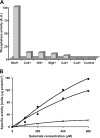Mutual regulation of ntcA and hetR during heterocyst differentiation requires two similar PP2C-type protein phosphatases, PrpJ1 and PrpJ2, in Anabaena sp. strain PCC 7120
- PMID: 19633087
- PMCID: PMC2747908
- DOI: 10.1128/JB.01271-08
Mutual regulation of ntcA and hetR during heterocyst differentiation requires two similar PP2C-type protein phosphatases, PrpJ1 and PrpJ2, in Anabaena sp. strain PCC 7120
Abstract
The filamentous cyanobacterium Anabaena sp. strain PCC 7120 can form heterocysts for N(2) fixation. Initiation of heterocyst differentiation depends on mutual regulation of ntcA and hetR. Control of hetR expression by NtcA is partially mediated by nrrA, but other factors must be involved in this regulation. Anabaena has two closely related PP2C-type protein phosphatases, PrpJ1 (formerly PrpJ) and PrpJ2; PrpJ1 is involved in heterocyst maturation. In this study, we show that PrpJ2, like PrpJ1, has Mn(2+)-dependent phosphatase activity. We further demonstrate that whereas prpJ2 is dispensable for cell growth under different nitrogen regimens tested, a double mutant with both prpJ1 and prpJ2 disrupted did not initiate heterocyst differentiation. Ectopic expression of hetR in the double mutant could rescue the failure to initiate heterocyst development, but the heterocysts formed, like those of a prpJ1 single mutant, were not mature. The expression of prpJ2 was enhanced during heterocyst development, and the upregulation of the gene was directly under the control of NtcA. Upregulation of both ntcA and hetR was affected in the double mutant. We propose that PrpJ1 and PrpJ2 together are required for mutual regulation of ntcA and hetR and are thus involved in regulation of the initiation of heterocyst differentiation.
Figures







Similar articles
-
NrrA directly regulates expression of hetR during heterocyst differentiation in the cyanobacterium Anabaena sp. strain PCC 7120.J Bacteriol. 2006 Dec;188(24):8520-5. doi: 10.1128/JB.01314-06. Epub 2006 Oct 13. J Bacteriol. 2006. PMID: 17041048 Free PMC article.
-
HetR-dependent and -independent expression of heterocyst-related genes in an Anabaena strain overproducing the NtcA transcription factor.J Bacteriol. 2005 Mar;187(6):1985-91. doi: 10.1128/JB.187.6.1985-1991.2005. J Bacteriol. 2005. PMID: 15743946 Free PMC article.
-
patD, a Gene Regulated by NtcA, Is Involved in the Optimization of Heterocyst Frequency in the Cyanobacterium Anabaena sp. Strain PCC 7120.J Bacteriol. 2019 Oct 4;201(21):e00457-19. doi: 10.1128/JB.00457-19. Print 2019 Nov 1. J Bacteriol. 2019. PMID: 31405917 Free PMC article.
-
The cell wall in heterocyst formation by Anabaena sp. PCC 7120.J Basic Microbiol. 2009 Feb;49(1):5-24. doi: 10.1002/jobm.200800300. J Basic Microbiol. 2009. PMID: 19253332 Review.
-
Genetic responses to carbon and nitrogen availability in Anabaena.Environ Microbiol. 2019 Jan;21(1):1-17. doi: 10.1111/1462-2920.14370. Epub 2018 Oct 16. Environ Microbiol. 2019. PMID: 30066380 Review.
Cited by
-
Three Substrains of the Cyanobacterium Anabaena sp. Strain PCC 7120 Display Divergence in Genomic Sequences and hetC Function.J Bacteriol. 2018 Jun 11;200(13):e00076-18. doi: 10.1128/JB.00076-18. Print 2018 Jul 1. J Bacteriol. 2018. PMID: 29686139 Free PMC article.
-
Formation and maintenance of nitrogen-fixing cell patterns in filamentous cyanobacteria.Proc Natl Acad Sci U S A. 2016 May 31;113(22):6218-23. doi: 10.1073/pnas.1524383113. Epub 2016 May 9. Proc Natl Acad Sci U S A. 2016. PMID: 27162328 Free PMC article.
-
An integrative approach for modeling and simulation of heterocyst pattern formation in cyanobacteria filaments.PLoS Comput Biol. 2015 Mar 27;11(3):e1004129. doi: 10.1371/journal.pcbi.1004129. eCollection 2015 Mar. PLoS Comput Biol. 2015. PMID: 25816286 Free PMC article.
-
Overexpression of pknE blocks heterocyst development in Anabaena sp. strain PCC 7120.J Bacteriol. 2011 May;193(10):2619-29. doi: 10.1128/JB.00120-11. Epub 2011 Mar 18. J Bacteriol. 2011. PMID: 21421755 Free PMC article.
References
-
- Awai, K., and C. P. Wolk. 2007. Identification of the glycosyl transferase required for synthesis of the principal glycolipid characteristic of heterocysts of Anabaena sp. strain PCC 712. FEMS. Microbiol. Lett. 266:98-102. - PubMed
-
- Black, T. A., Y. Cai, and C. P. Wolk. 1993. Spatial expression and autoregulation of hetR, a gene involved in the control of heterocyst development in Anabaena. Mol. Microbiol. 9:77-84. - PubMed
-
- Buikema, W. J., and R. Haselkorn. 1991. Characterization of a gene controlling heterocyst differentiation in the cyanobacterium Anabaena 7120. Genes Dev. 5:321-330. - PubMed
Publication types
MeSH terms
Substances
LinkOut - more resources
Full Text Sources

